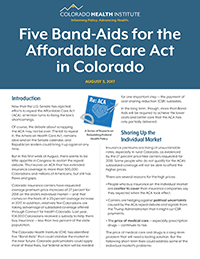Introduction
Now that the U.S. Senate has rejected efforts to repeal the Affordable Care Act (ACA), attention turns to fixing the law’s shortcomings.
Of course, the debate about scrapping the ACA may not be over. The bill to repeal it, the American Health Care Act, remains alive and on the Senate calendar, and Republican leaders could bring it up again at any time.

But in this first week of August, there seems to be little appetite in Congress to restart the repeal debate. That leaves an ACA that has extended insurance coverage to more than 500,000 Coloradans and millions of Americans, but still has flaws and gaps.
Colorado insurance carriers have requested average premium price increases of 27 percent for 2018 on the state’s individual market — and that comes on the heels of a 20 percent average increase in 2017. In addition, relatively few Coloradans are taking advantage of subsidized coverage offered through Connect for Health Colorado. Last year, 104,000 Coloradans received a subsidy to help them buy insurance — less than two percent of the state population.
The Colorado Health Institute (CHI) has identified five “Band-Aids” that could stabilize the market in the near future. Colorado policymakers could apply most of these fixes, but federal action will be needed for one important step — the payment of cost-sharing reduction (CSR) subsidies.
In the long term, though, more than Band-Aids will be required to achieve the lower costs and better care that the ACA has only partially delivered.
Shoring Up the Individual Market

CHI's research
on ACA
repeal.
Insurance premiums are rising at unsustainable rates, especially in rural Colorado, as evidenced by the 27 percent price hike carriers requested for 2018. Some people who do not qualify for the ACA’s subsidized coverage will not be able to afford the higher prices.
There are several reasons for the high prices:
• People who buy insurance on the individual market are costlier to cover than insurance companies say they expected when the ACA took effect.
• Carriers are hedging against political uncertainty caused by the ACA repeal debate and signals from the Trump Administration that it might cut CSR payments.
• The price of medical care — especially prescription drugs — continues to rise.
The price of medical care and drugs is a long-term problem that will need a lasting solution. But the following short-term fixes could address some of the individual market’s problems:
 Band-Aid Number One: Reinsurance
Band-Aid Number One: Reinsurance
State or federal solution? Either or, ideally, both
Reinsurance is like insurance for insurance companies. It shields companies against the chances some of their customers will incur high medical bills. With a reinsurance system in place, carriers should be more willing to participate in the individual market and offer lower premium prices.
Alaska created a reinsurance pool in 2016 to entice the lone company in its individual market to stay in the state. It’s credited for bringing price increases down to 7 percent, instead of a projected 42 percent. It was initially funded by the state, but the federal government this summer approved a waiver to direct federal funds to the program. Minnesota is awaiting federal approval of a similar request.
Colorado is considering a reinsurance pool. Senate Bill 17-300 requires the Division of Insurance to study the possibility. A work group that includes regulators and most major insurers is meeting this summer to craft a plan. Funding will be the biggest problem. The state could raise some money on its own, but federal support would help immensely. If the pool is done right, the federal government could save money by funding it, because lower premium prices would lead to lower federal subsidies.
 Band-Aid Number Two: Expanding Subsidies
Band-Aid Number Two: Expanding Subsidies
State or federal solution? State, ideally with federal funding
The ACA’s subsidies to buy insurance don’t cover everyone who needs it. Only people who make less than 400 percent of the federal poverty level — roughly $48,000 for a single person — qualify for help. People who earn more than the cutoff still have trouble affording expensive insurance premiums.
One temporary fix is to expand eligibility for subsidized coverage. The legislature this spring turned down a bill (House Bill 17-1235) to temporarily expand subsidies for people in Colorado’s highest-cost regions. The bill’s proposed $5.7 million in funding would have given modest subsidies to a small group — a projected 2,400 people.
This is an expensive option. Federal aid could allow more Coloradans access to expanded subsidies.
 Band-Aid Number Three: Enrollment Window and Outreach
Band-Aid Number Three: Enrollment Window and Outreach
State or federal solution? State
People with the highest health needs tend to be the first to sign up for insurance. Healthier people — who can improve the risk pool and bring down prices — tend to need more encouragement to sign up.
The Trump Administration has taken steps to discourage people from buying insurance by limiting the 2018 enrollment period in half to 45 days and by cutting back on advertising and outreach.
However, Colorado runs its own insurance marketplace, Connect for Health Colorado. Its open enrollment period is scheduled for November 1, 2017, to January 12, 2018. That’s shorter than the 2017 period but longer than the federal plan. While federal ads run in Colorado, Connect for Health also conducts its own outreach. State policymakers can make sure Connect for Health Colorado has enough resources to continue its outreach.
Perhaps more importantly, Colorado’s elected leaders can send the message that Connect for Health is open for business. Heavy media attention on congressional attempts to repeal the ACA needs to be counteracted by reminders that the ACA and Connect for Health Colorado still are functioning.
 Band-Aid Number Four: Cost-Sharing Reductions
Band-Aid Number Four: Cost-Sharing Reductions
State or federal solution? Federal
The ACA gives another set of subsidies to bring down out-of-pocket costs for people who earn less than 250 percent of the federal poverty level, about $30,000 a year. Insurance companies receive these subsidies directly. They are required to offer lower out-of-pocket costs to customers who buy silver plans, regardless of whether the federal government pays the subsidies.
An estimated 45,000 Coloradans receive these subsidies, according to Connect for Health Colorado.
House Republicans sued the Obama Administration, claiming the subsidies did not receive congressional approval. A lower court agreed, and the case has been tied up on appeal since President Trump took office. Meanwhile, the federal government has been sending subsidy payments to insurers.
President Trump has threatened to halt these payments. Insurers say the uncertainty is causing them to raise prices for their 2018 plans. Congress and the president could take action to lower insurance prices by withdrawing the lawsuit and making clear through legislation or executive action that the subsidies will continue.
 Band-Aid Number Five: Individual Mandate Enforcement
Band-Aid Number Five: Individual Mandate Enforcement
State or federal solution? State
The ACA contains a requirement for most people to purchase insurance. It’s one of the most controversial aspects of the law. The Trump Administration has discussed effectively ending the mandate by not enforcing the tax penalty. Doing so would likely lead to healthy people deciding to forego insurance — leaving a sicker, more expensive risk pool for everyone else.
Prior to the ACA, some states considered passing state-based individual mandates. Such a move would be highly controversial. But it could serve to prevent the deterioration of Colorado’s individual insurance market.
Addressing Medicaid Spending
There is no short-term Band-Aid for this topic.
Projected increases for federal and state Medicaid spending have worried many observers, especially congressional Republicans. Their solution has been to shift the risk and responsibility to the states by capping federal Medicaid spending, instead of continuing to reimburse states on a dollar-for-dollar basis for their increased costs. CHI projected that legislation to roll back the ACA Medicaid expansion and cap Medicaid spending would leave Colorado with a $15 billion budget gap by 2030.
The question for Colorado lawmakers is how to do more to contain costs without kicking people off the program. There are two broad options:
• See what the Accountable Care Collaborative (ACC) can do. The ACC is the state’s attempt to give care providers and administrators a stake in lowering costs by providing better coordinated care for their patients. The program has returned modest savings so far. It is entering a second phase with a focus on integrating behavioral health into the primary care setting. The ACC is Colorado’s main effort to contain Medicaid costs.
• Try again with managed care. Colorado tried Medicaid managed care in the past, but the system did not work well and resulted in lawsuits against the state. Recently, though, insurance companies have expressed interest in taking another look at it. Managed care would not necessarily lead to better cost savings than the ACC. But it could potentially include hospitals in cost-control efforts. Hospitals are a major part of Medicaid spending, but they are largely not participants in the ACC.
Beyond the ACA
The ACA took small steps toward addressing the greater problem: the U.S. spends more on health care and gets worse results than other developed countries. True reform will start to address the prices we pay for health care.
In the even longer term, lasting reform will address the negative effects our communities and social factors can have on our health.
Those reforms are likely to require an effort spanning a generation or more. They start with the political will to come to a consensus on the problem and its potential solutions. In the absence of political agreement on the big picture, though, state and federal policymakers can do a lot this year to take the edge off high insurance prices and stabilize the market after a tumultuous battle in Congress.

